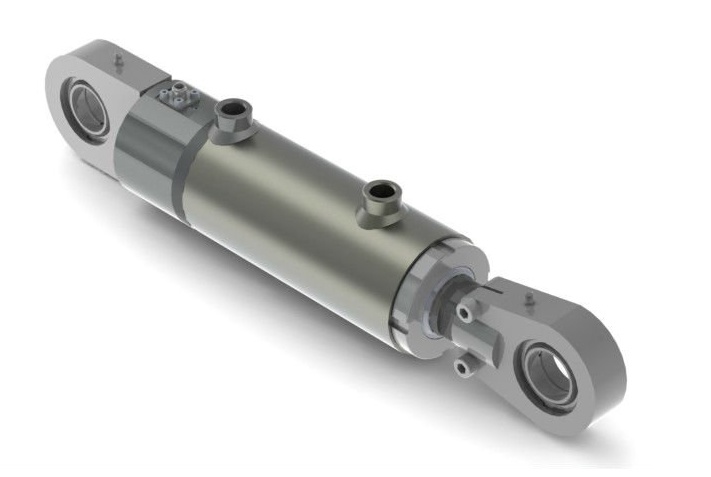Digitally controlled hydraulics represent the type of technological breakthrough the hydraulic cylinder industry seeks in the wake of increasing environmental regulation and rising energy costs. Typically, hydraulic pumps and motors are controlled by varying the stroke of pistons with an adjustable mechanism. But that technology has proved inefficient for automotive transmissions and wind turbines.
Enter Digital Displacement (DD) hydraulics, a power system with digitally controlled hydraulics that improves power capacity and overcomes the significant reliability issues associated with existing turbines.
Artemis Intelligent Power, a UK-based engineering firm, earned the prestigious 2015 Royal Academy of Engineering MacRobert Award for the innovation.
Win Rampen, Artemis’s founder and chairman, explains, "We developed digital displacement hydraulics, which is a way of turning off the capacity that you don't need without attracting a parasitic loss, and that was the fundamental starting point to make very efficient hydraulics which was both controllable and scalable to very big scales.”
The
MacRobert Award identifies outstanding innovation with proven commercial success and tangible social benefit, according to the Academy. Gordon Masterton, a judging panel member with the Academy,
said the DD system “is a massive leap forward for hydraulically powered systems. The (Artemis) team has done for hydraulic engines what James Watt did for steam engines; they have totally transformed the efficiency and range of potential applications.”
WHAT ARE HYDRAULIC CYLINDERS?
Hydraulic cylinders are used across many different industries such as construction, material handling, mining, oil and gas, marine, aerospace and defense, agriculture and the heavy equipment industry,
says BCC Research analyst Aneesh Kumar.
Hydraulic cylinders are broadly divided into two types: single acting hydraulic cylinders and double acting hydraulic cylinders. “Single acting hydraulic cylinders apply hydraulic force in only one direction, usually to extend the cylinder,” Kumar explains. “Whereas, double acting cylinders have two ports for the intake and outtake of hydraulic fluids. The pressure from the fluid can be used in both directions in order to expand and retract the piston. It can be mounted in any direction for lifting, pushing and pulling operations.”
DIGITAL DISPLACEMENT HYDRAULICS POWERING A GREENER SOLUTION
Artemis’s new DD power system controls output by digitally enabling individual cylinders on a stroke-by-stroke basis. Each cylinder is provided with electronically-controlled digital valves, capable to change state in few milliseconds. Each cylinder may be switched from idle, motoring or pumping cycles once every shaft revolution, in a pattern determined by an embedded controller. The result produces much faster and more accurate control response compared to variable-stroke machines.
The Mitsubishi-owned Artemis made news earlier this year when the world’s largest floating offshore wind-turbine, outfitted with a DD transmission hydraulic system, was deployed 23km off the Fukushima coast.
The company is applying the technology to reduce the fuel consumption of commuter trains and buses, as well. A regenerative braking energy storage system based on their DD technology can be retrofitted to existing diesel commuter trains has demonstrated it can reduce fuel consumption by some 10%. The system also generates less noise and cuts exhaust emissions within stations.
The DD system in hybrid buses has demonstrated fuel savings of up to 27% on urban buses. The many expensive materials and processes required by mainstream electric hybrid technology can add as much as 50% to the initial price tag, along with higher maintenance costs. Whereas the new system is made of common materials using regular processes, which lowers costs and allows system maintenance by existing staff. It also allows bus operators with a 2-3 year payback without subsidies, making it globally affordable, an important consideration for emerging countries such as China and India.
According to BCC Research analyst Kumar, the rapidly growing emerging economies, which are mainly China and India in terms of both economy and infrastructure, have significantly increased the demand for hydraulic cylinders in the past five years. The Asia-Pacific region has also become the hub for Western markets to outsource the manufacture of their hydraulic cylinders.
India and China are the major markets for hydraulic cylinders in the Asia-Pacific region, excluding Japan,” Kumar says. “The hydraulic cylinder market in India has been growing at an average of more than 20% over the last five years and currently constitutes about 40% ($195 million) of the total hydraulic components market in India with well-established players. Although Western markets remain the largest markets in terms of revenue, the Asia-Pacific region is expected to grow enormously at a five-year CAGR of 5.6%, over 2013 to 2018.”



